The Spatio-Temporal Pattern of Regional Coordinated Development in the Common Prosperity Demonstration Zone—Evidence from Zhejiang Province
Abstract
:1. Introduction
2. Indicator System and Data Sources
2.1. Indicator System
2.2. Data Sources and Study Area
3. Methods
3.1. PCA-TOPSIS Model
3.1.1. Standardization of Initial Indicator Data
3.1.2. Principal Component Analysis to Determine Weights
3.1.3. TOPSIS Model Development Level Measurements
3.2. Coordinated Development Model
3.3. Theil Index
3.4. Exploratory Spatial Data Analysis
3.4.1. Global Moran’s Index
3.4.2. Local Moran’s Index
4. Empirical Results
4.1. Regional Development Level Analysis
4.2. Regional Coordinated Development Level Analysis
4.2.1. Degree of Regional Coordinated Development
4.2.2. Regional Coordinated Development Level
4.3. Regional Differences Analysis
4.3.1. Intra- and Inter-Regional RCD Differences Analysis
4.3.2. Spatial Differentiation Characteristics
4.4. Spatial Pattern Analysis
4.4.1. Global Spatial Autocorrelation Analysis
4.4.2. Local Spatial Autocorrelation Analysis
5. Conclusions and Policy Recommendations
5.1. Conclusions
5.2. Policy Recommendations
5.2.1. Economic Perspective
5.2.2. Social Perspective
5.2.3. Ecological Perspective
5.3. Limitations and Future Research
Author Contributions
Funding
Institutional Review Board Statement
Informed Consent Statement
Data Availability Statement
Conflicts of Interest
References
- Liu, L. The Construction of China’s Social Governance Community and Solid Promotion of Common Prosperity. Reform 2022, 8, 87–97. (In Chinese) [Google Scholar]
- Ma, H. “Common Prosperity” in the Historical Logic of Marxism. Philos. Anal. 2022, 13, 98–110+198. (In Chinese) [Google Scholar]
- Dong, X.; Li, J.; Chi, R. A Study on Xi Jingpin’s Important Expositions on Coordinated Regional Development. J. Zhejiang Univ. (Humanit. Soc. Sci.) 2019, 49, 16–28. (In Chinese) [Google Scholar]
- Zhu, X.-G.; Li, T.; Feng, T.-T. On the Synergy in the Sustainable Development of Cultural Landscape in Traditional Villages under the Measure of Balanced Development Index: Case Study of the Zhejiang Province. Sustainability 2022, 14, 11367. [Google Scholar] [CrossRef]
- Qin, C.; Zheng, Y.; Zhang, H. A Study on the Tendencies and Features of the Coordinated Development of Regional Economy in China. Econ. Geogr. 2013, 33, 9–14. [Google Scholar] [CrossRef]
- Yang, Q. Measurement of China’s “Five Transformations” and its Spatial Pattern of Coordinated Development. China Agric. 2017, 10, 203–209. [Google Scholar] [CrossRef]
- Ruan, Y.; Xu, B. Measurement and evaluation of the degree of coordinated development of urban and rural areas. Stat. Decis. Mak. 2017, 19, 136–138. [Google Scholar] [CrossRef]
- Deng, H.; Cao, Y. Coordinated Development Performance in China. Reg. Econ. Rev. 2019, 1, 25–32. [Google Scholar] [CrossRef]
- Chen, L.; Yu, J.; Xu, Y. Construction of the Common Prosperity Index Model. Gov. Stud. 2021, 37, 5–16+2. [Google Scholar] [CrossRef]
- Ren, Z.L. Evaluation Method of Port Enterprise Product Quality Based on Entropy Weight TOPSIS. J. Coast. Res. 2020, 103, 766–769. [Google Scholar] [CrossRef]
- de Cheveigne, A. Quadratic component analysis. Neuroimage 2012, 59, 3838–3844. [Google Scholar] [CrossRef] [PubMed]
- Alaoui, Y.L.; Tkiouat, M. Assessing the performance of microfinance lending process using AHP-fuzzy comprehensive evaluation method: Moroccan case study. Int. J. Eng. Bus. Manag. 2017, 9. [Google Scholar] [CrossRef]
- Cao, W.; Zhang, X.; Pan, Y.; Zhang, C. Coordinate Development among Population, Land and Economy Urbanization in Developed Area: The Case of Jiangsu Province. China Popul. Resour. Environ. 2012, 22, 141–146. (In Chinese) [Google Scholar]
- Malakar, K.; Mishra, T. Application of Gini, Theil and concentration indices for assessing water use inequality. Int. J. Soc. Econ. 2017, 44, 1335–1347. [Google Scholar] [CrossRef]
- Chakravarty, S.R.; Silber, J. A generalized index of employment segregation. Math. Soc. Sci. 2007, 53, 185–195. [Google Scholar] [CrossRef]
- Barvels, E.; Fensholt, R. Earth Observation-Based Detectability of the Effects of Land Management Programmes to Counter Land Degradation: A Case Study from the Highlands of the Ethiopian Plateau. Remote Sens. 2021, 13, 1297. [Google Scholar] [CrossRef]
- Sun, Y.; Shen, S. The spatio-temporal evolutionary pattern and driving forces mechanism of green technology innovation efficiency in the Yangtze River Delta region. Geogr. Res. 2021, 40, 2743–2759. (In Chinese) [Google Scholar]
- Munibah, K.; Widiatmaka, W.; Widjaja, H. Spatial Autocorrelation on Public Facility Availability Index with Neighborhoods Weight Difference. J. Reg. City Plan. 2018, 29, 18–31. [Google Scholar] [CrossRef]
- Lu, Q.; Yang, Y.; Li, B.; Li, Y.; Wang, D. Coupling Relationship and Influencing Factors of the Water-Energy-Cotton System in Tarim River Basin. Agronomy 2022, 12, 2333. [Google Scholar] [CrossRef]
- Huang, H.; Zou, C.; Cao, J.; Tsang, P.; Zhu, F.; Yu, C.; Xue, S. Water-soluble Ions in PM2.5 on the Qianhu Campus of Nanchang University, Nanchang City: Indoor-Outdoor Distribution and Source Implications. Aerosol Air Qual. Res. 2012, 12, 435–443. [Google Scholar] [CrossRef]
- Zheng, Y.; Xuehua, Z. Principal component method in analysis of water resources sustainability influence factors. In Proceedings of the 2009 International Conference on Management and Service Science, Beijing, China, 20–22 September 2009; p. 4. [Google Scholar]
- An, H.; Xu, J.; Ma, X. Does technological progress and industrial structure reduce electricity consumption? Evidence from spatial and heterogeneity analysis. Struct. Change Econ. Dyn. 2020, 52, 206–220. [Google Scholar] [CrossRef]
- Jiaxing, Z.; Lin, L.; Hang, L.; Dongmei, P. Evaluation and analysis on suitability of human settlement environment in Qingdao. PLoS ONE 2021, 16, e0256502. [Google Scholar] [CrossRef] [PubMed]
- Zavadskas, E.K.; Mardani, A.; Turskis, Z.; Jusoh, A.; Nor, K.M.D. Development of TOPSIS Method to Solve Complicated Decision-Making Problems: An Overview on Developments from 2000 to 2015. Int. J. Inf. Technol. Decis. Mak. 2016, 15, 645–682. [Google Scholar] [CrossRef]
- Ishizaka, A.; Balkenborg, D.; Kaplan, T. Does AHP help us make a choice? An experimental evaluation. J. Oper. Res. Soc. 2011, 62, 1801–1812. [Google Scholar] [CrossRef]
- Chen, C.; Zhang, Y.; An, J.G.; He, Y.; Gong, X. Comparative Study of Four Maxillofacial Trauma Scoring Systems and Expert Score. J. Oral Maxillofac. Surg. 2014, 72, 2212–2220. [Google Scholar] [CrossRef]
- Liwicki, S.; Tzimiropoulos, G.; Zafeiriou, S.; Pantic, M. Euler Principal Component Analysis. Int. J. Comput. Vis. 2013, 101, 498–518. [Google Scholar] [CrossRef]
- Choulakian, V. Robust Q-mode principal component analysis in L-1. Comput. Stat. Data Anal. 2001, 37, 135–150. [Google Scholar] [CrossRef]
- Jiang, B. Head/Tail Breaks: A New Classification Scheme for Data with a Heavy-Tailed Distribution. Prof. Geogr. 2013, 65, 482–494. [Google Scholar] [CrossRef]
- Zhu, S.; Xu, B.; Mao, J. The evaluation on urban ecosystem health and its obstacle degree: A case study on Nanning City. J. Anhui Univeisity (Nat. Sci. Ed.) 2015, 39, 96–102. (In Chinese) [Google Scholar]
- Jiang, X.; Wu, X. Quantitative investigation of the coordinated development of ecology-economysociety in forest resource-based city: A case study of Yichun, Heilongjiang Province. Acta Ecol. Sin. 2021, 41, 8396–8407. (In Chinese) [Google Scholar]
- Liao, C. Quantitaitve Judgement and Classification System for Coordinated Development of Environment Amd Economy—A Case Study of the City Group in the Pearl River Delta. Trop. Geography. 1999, 19, 76–82. (In Chinese) [Google Scholar]
- Cheng, C.; Liu, Y.L.; Liu, Y.F.; Yang, R.F.; Hong, Y.S.; Lu, Y.C.; Pan, J.W.; Chen, Y.Y. Cropland use sustainability in Cheng-Yu Urban Agglomeration, China: Evaluation framework, driving factors and development paths. J. Clean. Prod. 2020, 256, 120692. [Google Scholar] [CrossRef]
- Sun, F.; Ye, C. Modelling of the environmental sustainability assessment index for inhabited islands. Earth Sci. Inform. 2022, 15, 1385–1394. [Google Scholar] [CrossRef]
- Cui, Y.; Khan, S.U.; Sauer, J.; Zhao, M. Exploring the spatiotemporal heterogeneity and influencing factors of agricultural carbon footprint and carbon footprint intensity: Embodying carbon sink effect. Sci. Total Environ. 2022, 846, 157507. [Google Scholar] [CrossRef] [PubMed]
- Li, R.; Sun, T. Research on Measurement of Regional Differences and Decomposition of Influencing Factors of Carbon Emissions of China’s Logistics Industry. Pol. J. Environ. Stud. 2021, 30, 3137–3150. [Google Scholar] [CrossRef]
- Yu, X.; Gong, S.; Wu, Y. Spatial Statistical Analysis on the Variability of County Economies in Zhejiang Province. Areal Res. Dev. 2012, 31, 27–32. (In Chinese) [Google Scholar]
- Zhang, W.; Wang, B.; Wang, J.; Wu, Q.; Wei, Y.D. How does industrial agglomeration affect urban land use efficiency? A spatial analysis of Chinese cities. Land Use Policy 2022, 119, 106178. [Google Scholar] [CrossRef]
- Kumari, M.; Sarma, K.; Sharma, R. Using Moran’s I and GIS to study the spatial pattern of land surface temperature in relation to land use/cover around a thermal power plant in Singrauli district, Madhya Pradesh, India. Remote Sens. Appl. Soc. Environ. 2019, 15, 100239. [Google Scholar] [CrossRef]
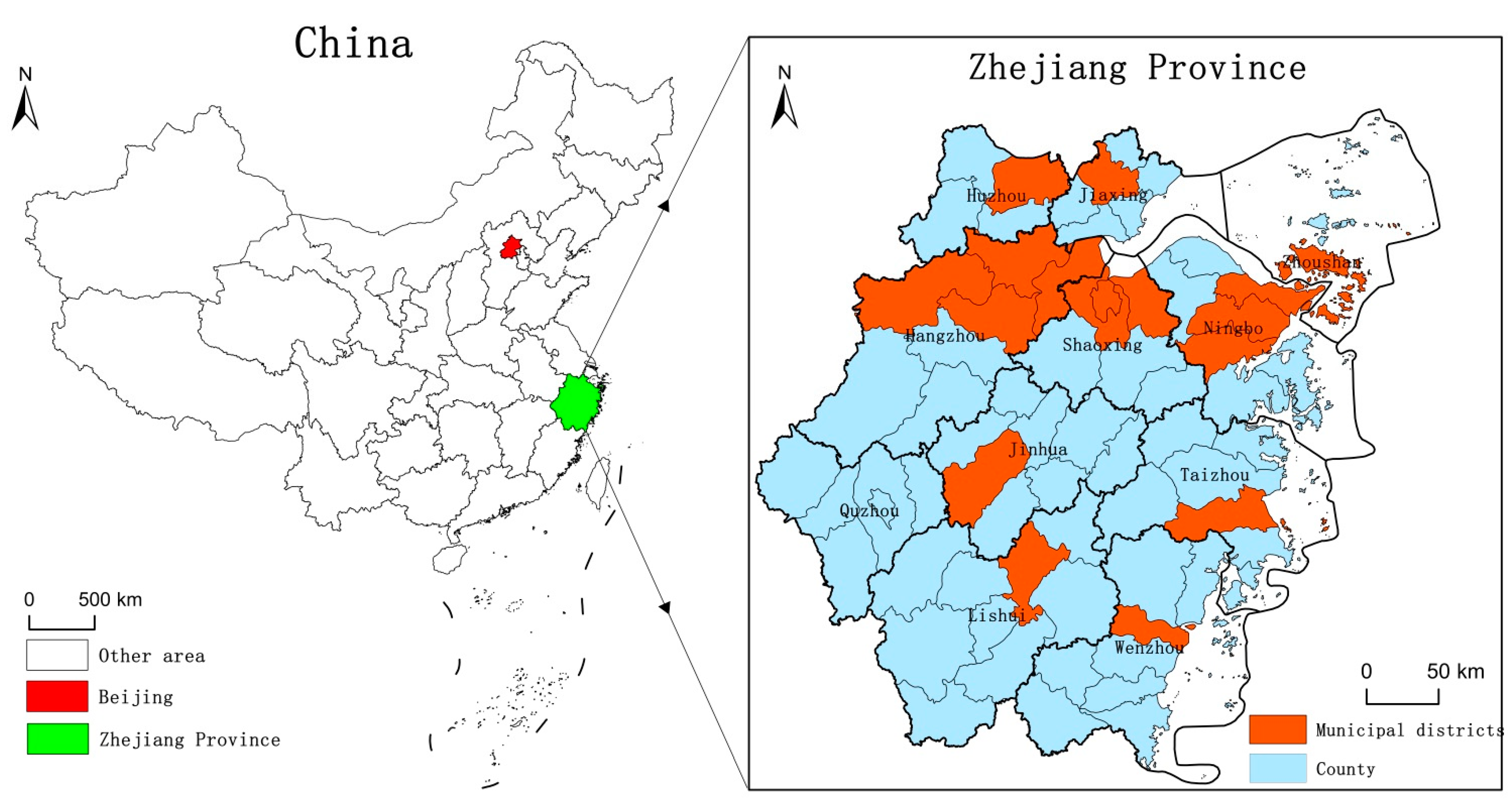
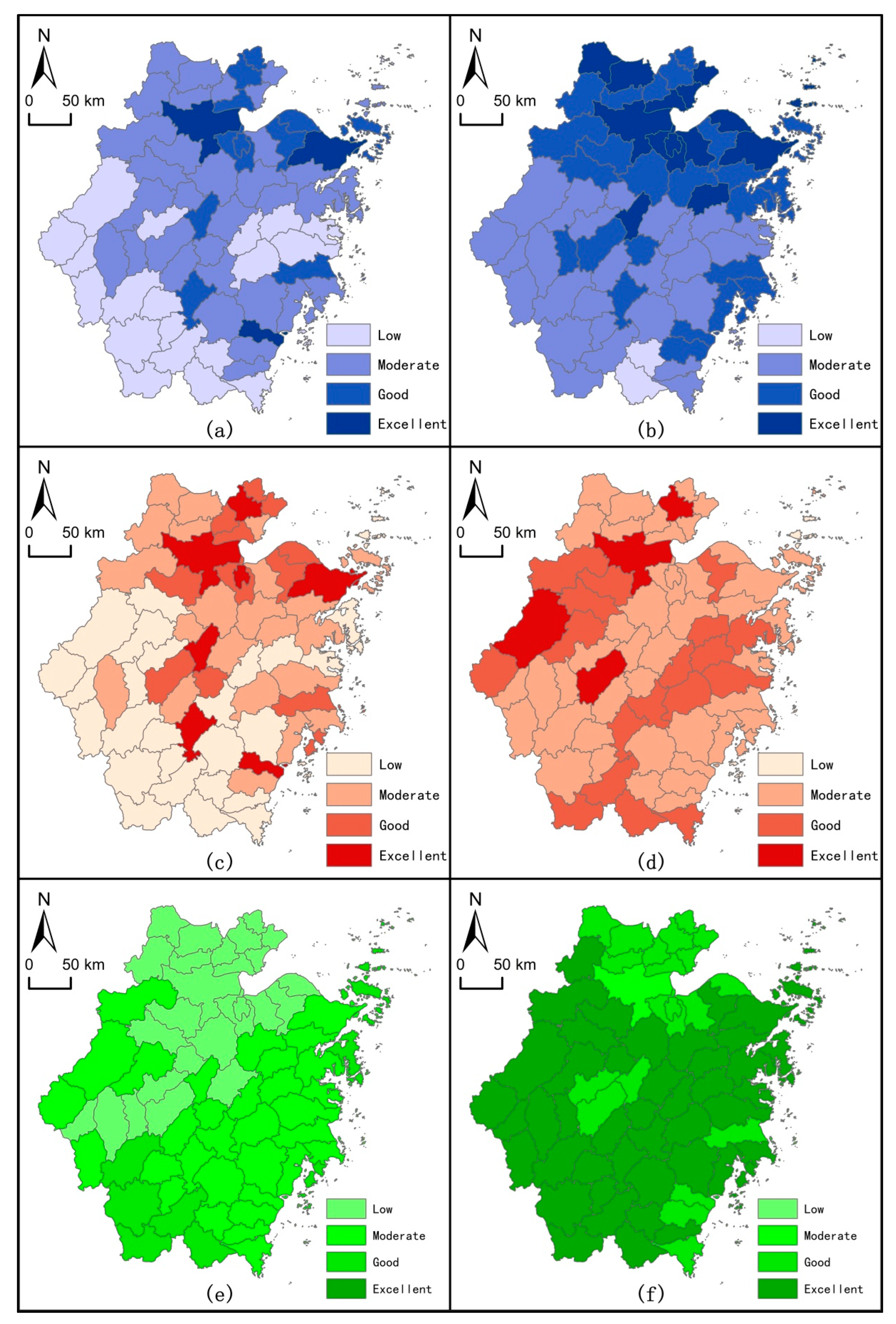
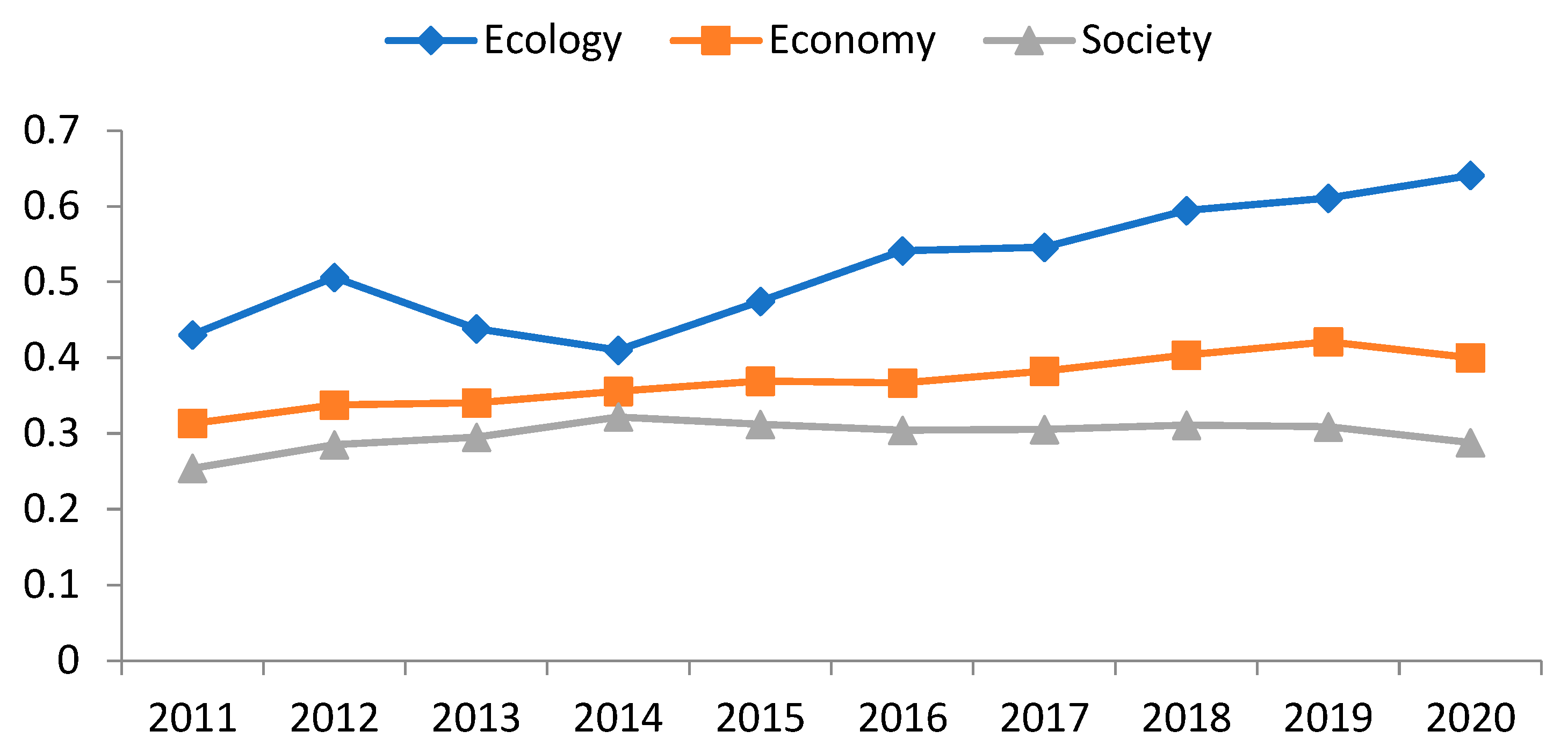
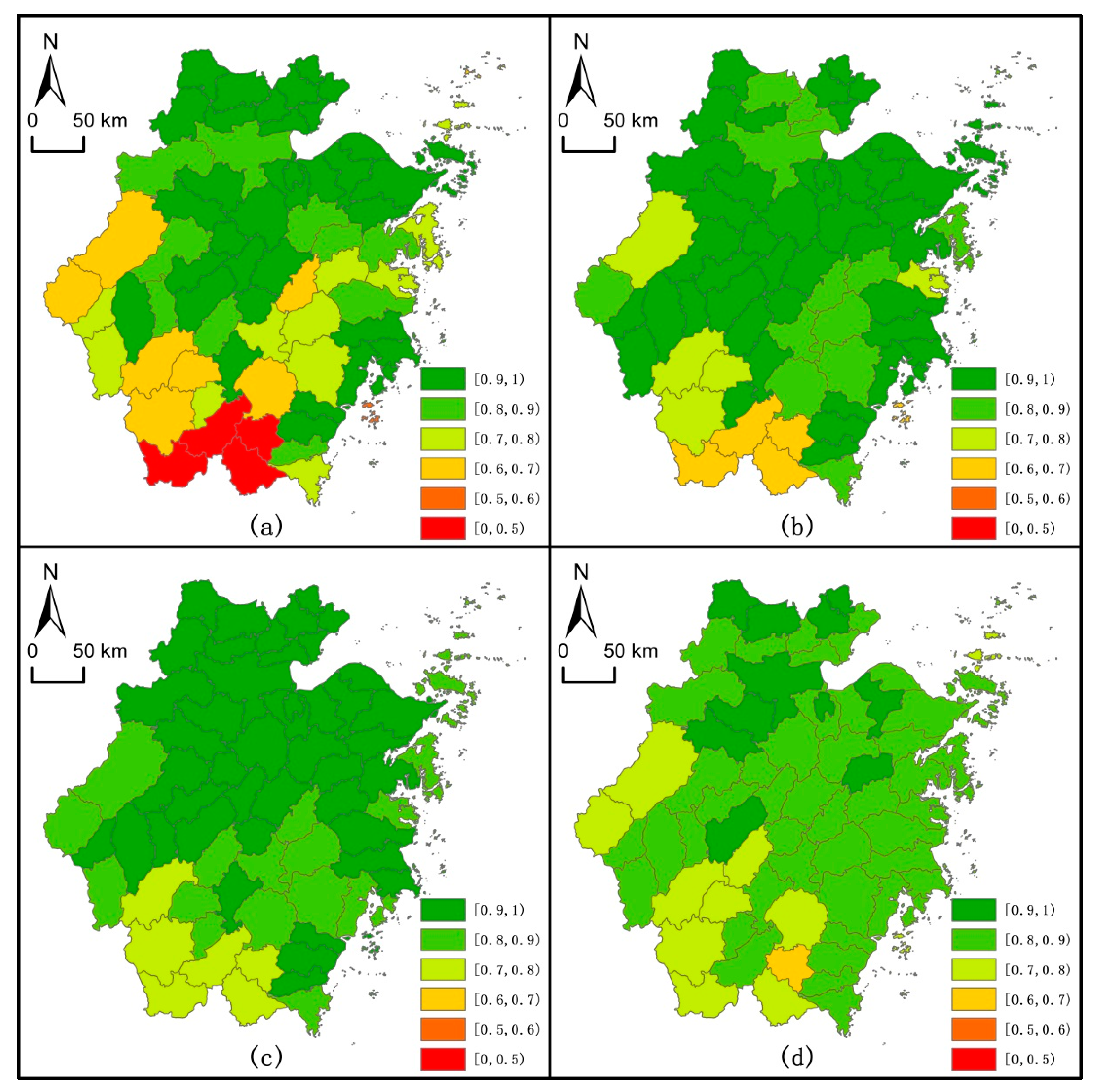

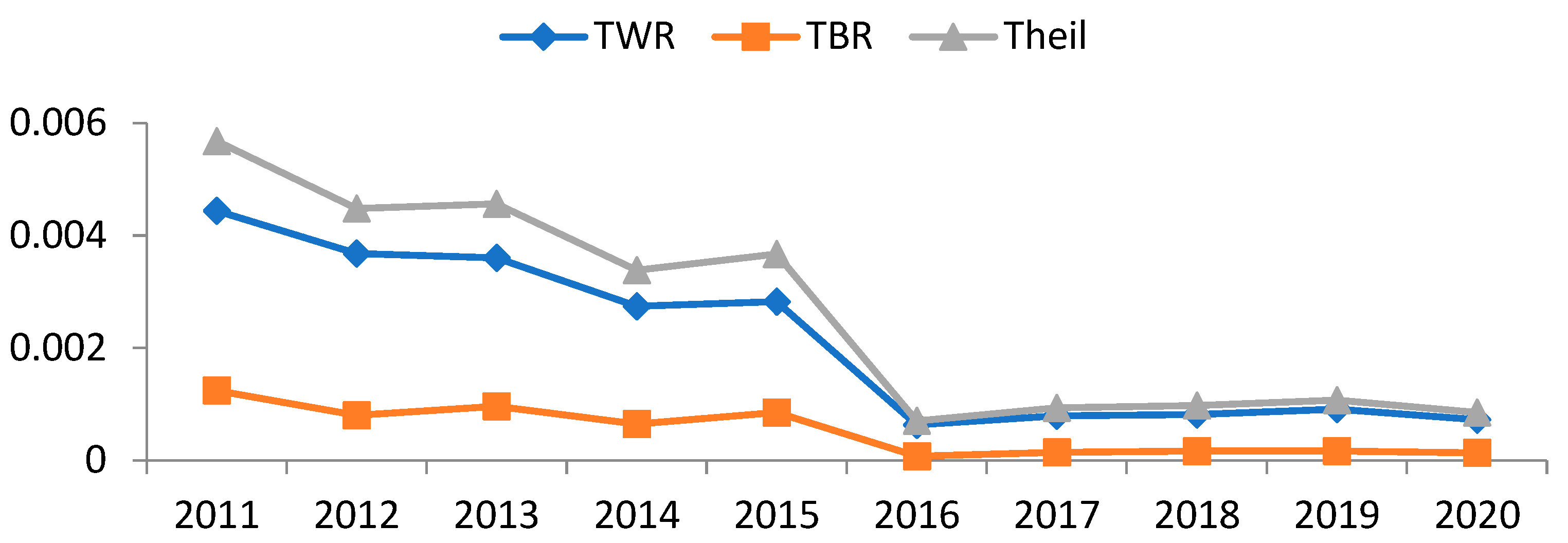

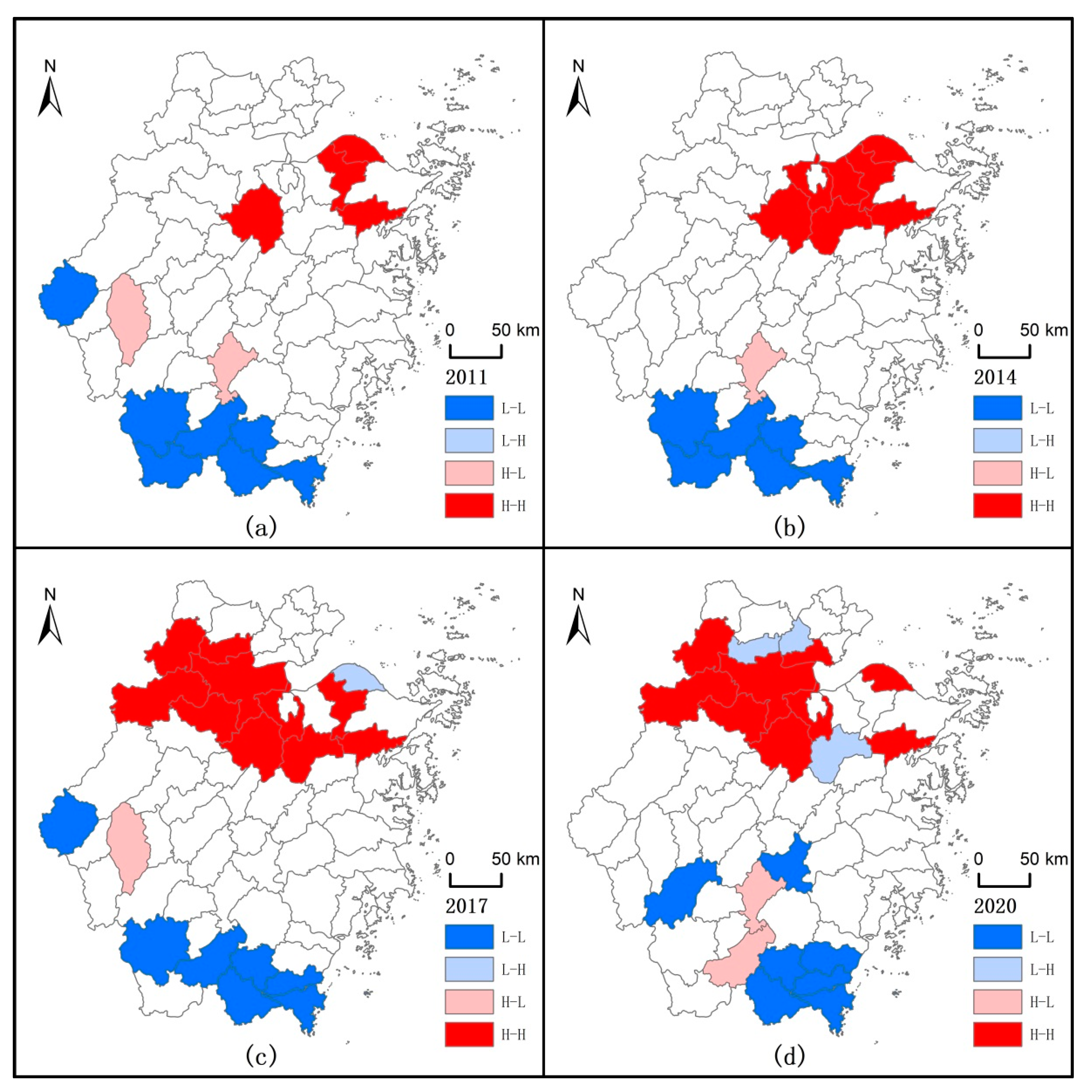
| Target Layer | Criterion Layer | Indicator Layer | Direction | Weight |
|---|---|---|---|---|
| Economic Subsystem | Economic strength | Per capita GDP (CNY 10,000) | Positive | 23.03 |
| Per capita total retail sales of consumer goods | Positive | 25.55 | ||
| Per capita local fiscal revenue (CNY 10,000) | Positive | 22.89 | ||
| Economic structure | The ratio of the tertiary industry to GDP (%) | Positive | 3.19 | |
| Industrial output as a ratio of industrial and agricultural industries (%) | Positive | 17.04 | ||
| Economic openness | Total imports and exports (USD 10,000) | Positive | 8.30 | |
| Social Subsystem | Infrastructure | Number of beds in medical institutions per 10,000 population (beds per 10,000 population) | Positive | 12.83 |
| Mobile phone subscriptions per capita (households/person) | Positive | 13.15 | ||
| Freight traffic per capita (tons/person) | Positive | 6.72 | ||
| Social Security | Urban to rural income ratio (%) | Negative | 3.04 | |
| Medical insurance coverage (%) | Positive | 13.50 | ||
| Pension insurance coverage (%) | Positive | 9.52 | ||
| Unemployment insurance coverage (%) | Positive | 13.33 | ||
| Science and Education | Education as a share of fiscal expenditure (%) | Positive | 6.94 | |
| Number of primary and secondary school students per capita (students) | Positive | 11.31 | ||
| Number of invention patents per 10,000 people (pieces per 10,000 people) | Positive | 9.65 | ||
| Ecological Subsystem | Resource utilization | Crop area is sown per capita (thousands of hectares per 10,000 people) | Positive | 26.46 |
| Environmental quality | Air quality PM2.5 concentration (μg/m3) | Negative | 50.69 | |
| Green development | Carbon emissions per unit of GDP (million tons/billion RMB) | Negative | 22.85 |
| Closeness | Level |
|---|---|
| [0, ] | Low |
| [, ] | Moderate |
| [, ] | Good |
| [, 1] | Excellent |
| Coordination Degree | Level |
|---|---|
| [0, 0.5) | Uncoordinated |
| [0.5, 0.6) | Barely coordination |
| [0.6, 0.7) | Primary coordination |
| [0.7, 0.8) | Moderate coordination |
| [0.8, 0.9) | Good coordination |
| [0.9, 1) | Excellent coordination |
| Coordinated Development | Level |
|---|---|
| [0, 0.3) | Severe dysregulation recession |
| [0.3, 0.4) | Severe dysregulation recession |
| [0.4, 0.5) | Severe dysregulation recession |
| [0.5, 0.55) | Moderate coordination development |
| [0.55, 0.7) | Good coordination development |
| [0.7, 1) | Excellent coordination development |
| Region | Cities |
|---|---|
| North | Hangzhou, Ningbo, Shaoxing, Huzhou, Jiaxing, Zhoushan |
| Southeast | Wenzhou, Taizhou |
| Southwest | Jinhua, Lishui, Quzhou |
| Year | TWR | TBR | Theil | WW | Wb |
|---|---|---|---|---|---|
| 2011 | 0.00444 | 0.00124 | 0.00568 | 0.78185 | 0.21815 |
| 2012 | 0.00368 | 0.00080 | 0.00448 | 0.82046 | 0.17954 |
| 2013 | 0.00360 | 0.00096 | 0.00456 | 0.79015 | 0.20985 |
| 2014 | 0.00274 | 0.00064 | 0.00338 | 0.81014 | 0.18986 |
| 2015 | 0.00282 | 0.00085 | 0.00367 | 0.76846 | 0.23154 |
| 2016 | 0.00063 | 0.00007 | 0.00070 | 0.89657 | 0.10343 |
| 2017 | 0.00079 | 0.00014 | 0.00093 | 0.84619 | 0.15381 |
| 2018 | 0.00081 | 0.00016 | 0.00097 | 0.83804 | 0.16196 |
| 2019 | 0.00091 | 0.00016 | 0.00107 | 0.84848 | 0.15152 |
| 2020 | 0.00072 | 0.00013 | 0.00085 | 0.85088 | 0.14912 |
| Year | Northern | Southeast | Southwest | Wnorthern | Wsoutheast | Wsouthwest |
|---|---|---|---|---|---|---|
| 2011 | 0.00621 | 0.00155 | 0.00406 | 0.36127 | 0.18919 | 0.23138 |
| 2012 | 0.00576 | 0.00132 | 0.00232 | 0.37964 | 0.19444 | 0.24638 |
| 2013 | 0.00536 | 0.00132 | 0.00280 | 0.35930 | 0.19364 | 0.23720 |
| 2014 | 0.00388 | 0.00103 | 0.00240 | 0.36822 | 0.19622 | 0.24570 |
| 2015 | 0.00406 | 0.00105 | 0.00236 | 0.35269 | 0.18523 | 0.23053 |
| 2016 | 0.00096 | 0.00032 | 0.00040 | 0.40442 | 0.21100 | 0.28115 |
| 2017 | 0.00127 | 0.00036 | 0.00042 | 0.38306 | 0.19979 | 0.26334 |
| 2018 | 0.00129 | 0.00034 | 0.00048 | 0.37901 | 0.19840 | 0.26064 |
| 2019 | 0.00140 | 0.00047 | 0.00054 | 0.38311 | 0.20137 | 0.26400 |
| 2020 | 0.00123 | 0.00035 | 0.00026 | 0.38778 | 0.19783 | 0.26527 |
| Year | Moran’s I | E(I) | Z Score | p Value |
|---|---|---|---|---|
| 2011 | 0.425 | −0.0193 | 5.5167 | 0.001 |
| 2012 | 0.451 | −0.0156 | 5.8532 | 0.001 |
| 2013 | 0.406 | −0.0156 | 5.3123 | 0.001 |
| 2014 | 0.364 | −0.0156 | 4.8046 | 0.001 |
| 2015 | 0.422 | −0.0156 | 5.5257 | 0.001 |
| 2016 | 0.314 | −0.0156 | 4.1347 | 0.001 |
| 2017 | 0.358 | −0.0156 | 4.6830 | 0.001 |
| 2018 | 0.361 | −0.0156 | 4.7271 | 0.001 |
| 2019 | 0.321 | −0.0156 | 4.1867 | 0.001 |
| 2020 | 0.356 | −0.0156 | 4.7383 | 0.001 |
Disclaimer/Publisher’s Note: The statements, opinions and data contained in all publications are solely those of the individual author(s) and contributor(s) and not of MDPI and/or the editor(s). MDPI and/or the editor(s) disclaim responsibility for any injury to people or property resulting from any ideas, methods, instructions or products referred to in the content. |
© 2023 by the authors. Licensee MDPI, Basel, Switzerland. This article is an open access article distributed under the terms and conditions of the Creative Commons Attribution (CC BY) license (https://creativecommons.org/licenses/by/4.0/).
Share and Cite
Xu, B.; Liu, L.; Sun, Y. The Spatio-Temporal Pattern of Regional Coordinated Development in the Common Prosperity Demonstration Zone—Evidence from Zhejiang Province. Sustainability 2023, 15, 2939. https://doi.org/10.3390/su15042939
Xu B, Liu L, Sun Y. The Spatio-Temporal Pattern of Regional Coordinated Development in the Common Prosperity Demonstration Zone—Evidence from Zhejiang Province. Sustainability. 2023; 15(4):2939. https://doi.org/10.3390/su15042939
Chicago/Turabian StyleXu, Binkai, Lei Liu, and Yanming Sun. 2023. "The Spatio-Temporal Pattern of Regional Coordinated Development in the Common Prosperity Demonstration Zone—Evidence from Zhejiang Province" Sustainability 15, no. 4: 2939. https://doi.org/10.3390/su15042939
APA StyleXu, B., Liu, L., & Sun, Y. (2023). The Spatio-Temporal Pattern of Regional Coordinated Development in the Common Prosperity Demonstration Zone—Evidence from Zhejiang Province. Sustainability, 15(4), 2939. https://doi.org/10.3390/su15042939






